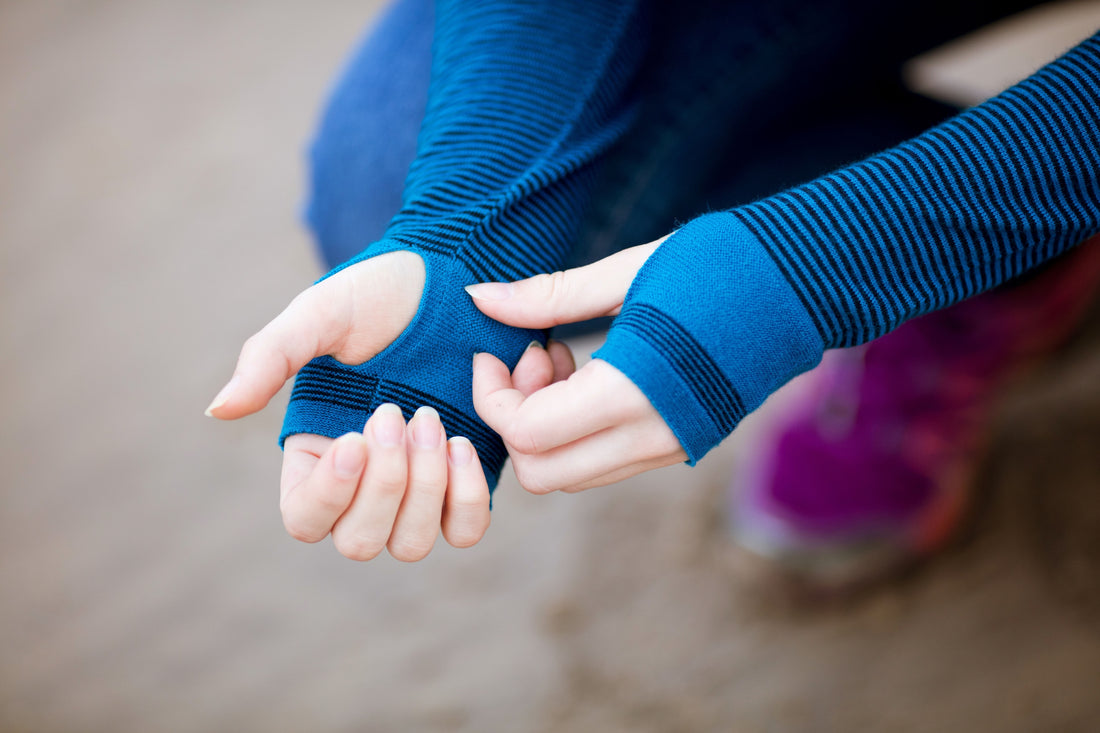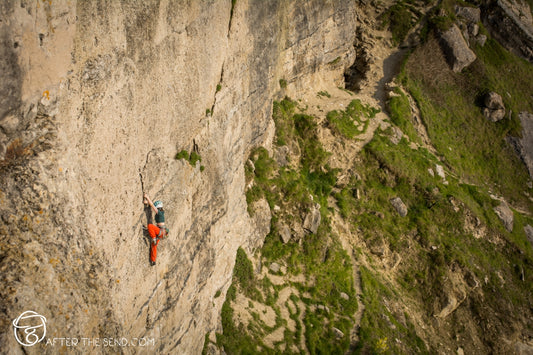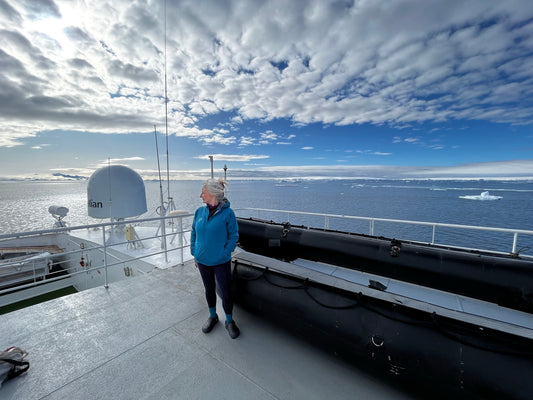Alex was recently asked by Outdoor Swimmer to talk about the advantages of Merino wool, particularly for post-wild swim warmth. With longer days ahead and our minds shifting to new outdoor activities, we thought it would be great to share Alex's insights with you. Here's how to be warm after a cold-water swim!
Here is Alex's interview in full. (Link at the end).
What are the benefits of merino as opposed to other common materials (synthetic, cotton etc)?
The hardy sheep that produce merino wool are reared in environments with extreme weather conditions which has led their fleeces to evolve some incredible features that allow them to adapt to these extremities. Thus, merino wool fibres have a range of properties such as natural temperature regulation and odour resistance, that ensure the sheep’s survival.
The structural varieties of wool fibres are measured in microns. A micron is the diameter of one wool fibre and generally, the lower the micron count, the softer the wool. While Lambswool typically has a micron count of around 25, Merino ranges between 15 and 20.
As well as a low micron count, Merino fibres have a good crimp (coiled texture). This allows the resulting fabric to be soft and springy and works to trap air, giving it insulating properties. Compared to heavy cotton, which is often grown with heavy agrochemicals in desert environments where water is scarce, merino is lighter, softer and more breathable.

Beyond this, merino wool has several properties which make it a superior choice to synthetic materials…
- It’s biodegradable and will break down into its parts at the end of its life. It can even be composted or recycled at the end of its life.
- It’s a sustainable renewable fibre that is regenerated again and again by the merino sheep.
- No plastic microfibers in your washing machine unlike with synthetics and Merino’s natural odour-resistant and anti-bacterial qualities mean it is likely to use much less water over its lifecycle.
All these factors help to make Merino wool a more ethical and practical choice than synthetic alternatives and cotton.

What sort of layering system would you suggest for a cold-water swimmer?
The second you’ve dried off, you’re going to want to pull on a nice cosy base layer. The softer, the better. A high-wicking fabric like Merino is a great idea, as it will help you deal with any residual moisture and clamminess. When you’ve been open water swimming, especially in places like Scotland where the water can stay cold even in summer, you need lots of layers to help you raise and regulate your core temperature as quickly as possible.
Accessories are handy for adding warmth as soon as you get out of the water. Woolly socks and a woolly bobble hat are great to get your extremities warm instantly and keep the heat in. They can also be can be pulled on quickly, while arm and neck warmers are great for adding extra heat once you’re dressed. Our hot water bottle covers with pockets are a nice way to warm your hands up post-swim.

Please can you tell us about the different weights of merino garments - what works best for particular situations/temperatures?
All FINDRA Merino wool garments are designed to be part of a layering system and come in various weights. From super lightweight base layers to mid layers and then heavier outer layers. The choice of weight depends on the intended use and environmental conditions. The weight of a merino wool garment is often measured in grams per square meter (gsm), indicating the density of the fabric. Here are some weights we design the FINDRA garments around and their recommended uses:
Ultralight (less than 150 gsm). Best For:
- Warm weather, high-intensity activities.
- Use Cases: Running, hiking in hot climates, summer sports.
- Characteristics: Lightweight and breathable, ideal for moisture management and quick drying.
- Great next to the skin layers.
- Spring and Autumn seasons, moderate activity levels.
- Use Cases: Any activity really from hiking, backpacking, and cold water swimming to travelling in mild climates.
- Characteristics: Balances breathability with a bit more insulation, suitable for a range of temperatures.
- Cooler temperatures, versatile use.
- Use Cases: Autumn and spring outdoor activities, as a mid-layer in colder conditions and can be layered up over the base layer.
- Characteristics: Provides more insulation, suitable for a wide range of temperatures, and can serve as a standalone layer in milder conditions.
- Cold weather, low-intensity activities.
- Use Cases: Winter sports, camping in cold climates, as a base layer in freezing temperatures.
- Characteristics: Offers substantial warmth and insulation, suitable for very cold conditions.

Is there anything else we should be considering when choosing a merino layer? (e.g. non-mulesed wool, or garments being 100% seamless…)
Another important feature to look out for in FINDRA Merino garments is the 3D Seamless Knitting Technology which enables the clothing to be knitted in one piece rather than assembled in several sections. Not only does the lack of seams create a stronger, more durable garment that won’t rub on your skin or wear down at important points but it also reduces waste in the production process, Creating a Zero waste garment.
When choosing Merino garments make sure you purchase non-mulesed wool. The mulesing process can cause unnecessary suffering to sheep, and consumers increasingly advocate for products that align with humane farming practices. Mulesing is primarily aimed at preventing flystrike however this method involves removing strips of skin from the sheep's buttock without anaesthesia, causing pain and distress to the animals. Thus choosing non-mulesed wool reflects a commitment to the ethical treatment of animals.

Do you have any other advice you’d like to offer to outdoor swimmers wanting to warm up post-swim?
Warming up after an outdoor swim is crucial to prevent post-swimming chill and to promote overall well-being. Here are some additional tips for outdoor swimmers looking to warm up effectively:
Layer Up: Have a set of warm, dry layers ready for immediately after your swim. Dressing in layers helps trap heat close to your body and provides quick insulation. FINDRA Merino base layers are perfect.
Hot Beverages: Bring a thermos with a hot beverage like herbal tea, hot chocolate, or warm soup. Consuming a warm drink can help raise your internal body temperature.
Stay Active: Engage in light physical activity after your swim. Gentle movements, such as walking or light stretching, can help improve blood circulation and gradually raise your body temperature.
Sheltered Spot: Choose a sheltered area to change, especially if it's windy. Wind can increase the rate of heat loss from your body, making it harder to warm up.
Warm Shower: If possible, take a warm shower as soon as you can after getting out of the water. This helps to remove residual cold water from your body and promotes a quicker warm-up.
Massage or Rubdown: Give yourself a brisk rubdown or a quick self-massage to stimulate blood flow and generate warmth.
Bring a Hot Water Bottle: Pack a hot water bottle in your bag. Placing it on your lap or against your torso can provide instant warmth during your post-swim recovery. This can only be improved by our Coorie Hot Water bottles made of 100% lambswool and complete with a hand pouch to warm up your chilly fingers.

Woollen Accessories: Wear natural woollen accessories whether merino or lambswool, woollen socks, gloves, neck warmers and headbands will all help you to retain heat in those vital areas. Wool has excellent insulating properties and can help keep you warm even when damp.
Eat something sweet: Always take a little sweet treat with you to enjoy with your hot drink post-swim, a piece of chocolate or a small cake will help restore your glycogen levels.
Read the article here, and be sure to subscribe to Outdoor Swimmer for more tips on getting started!





